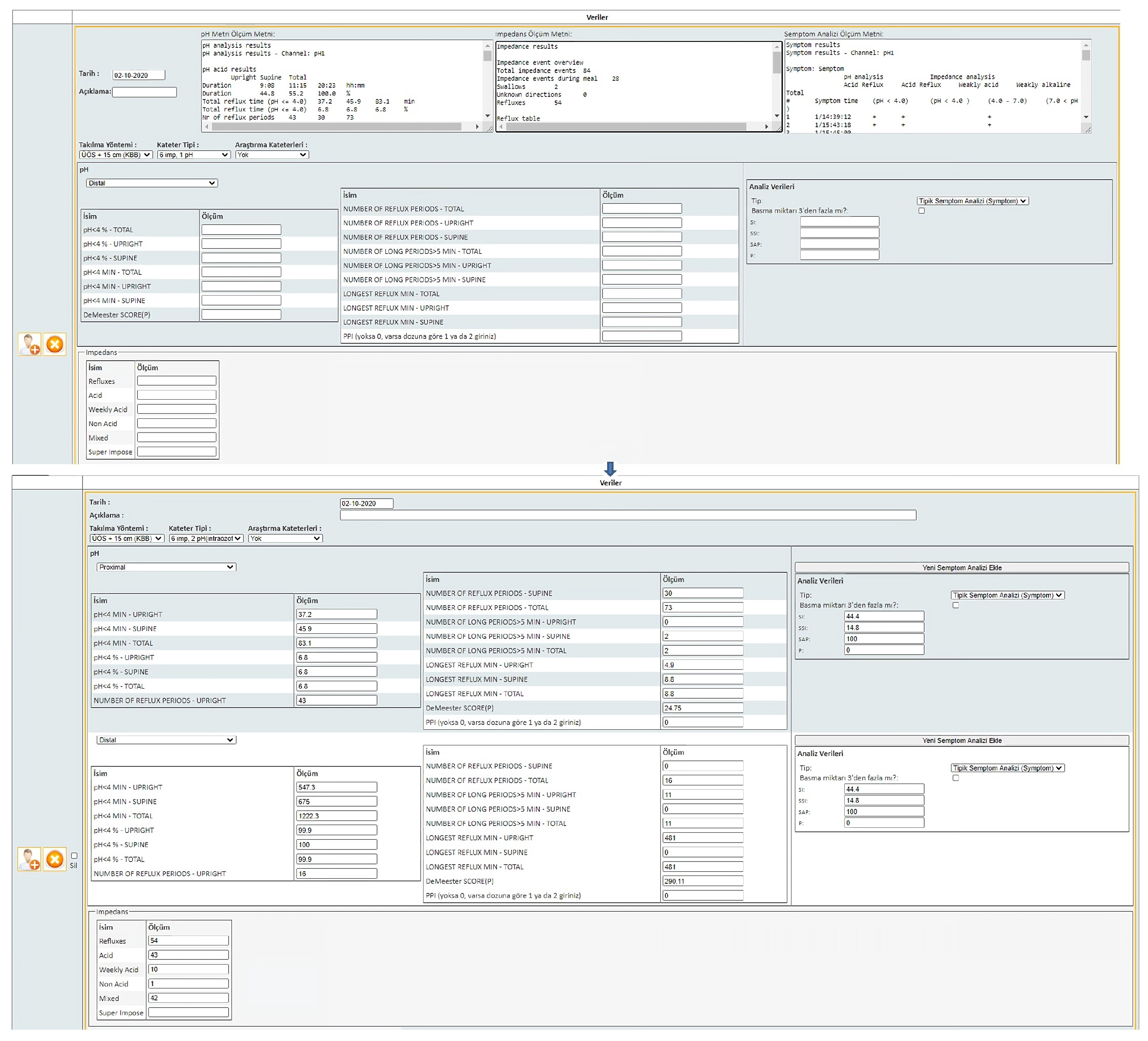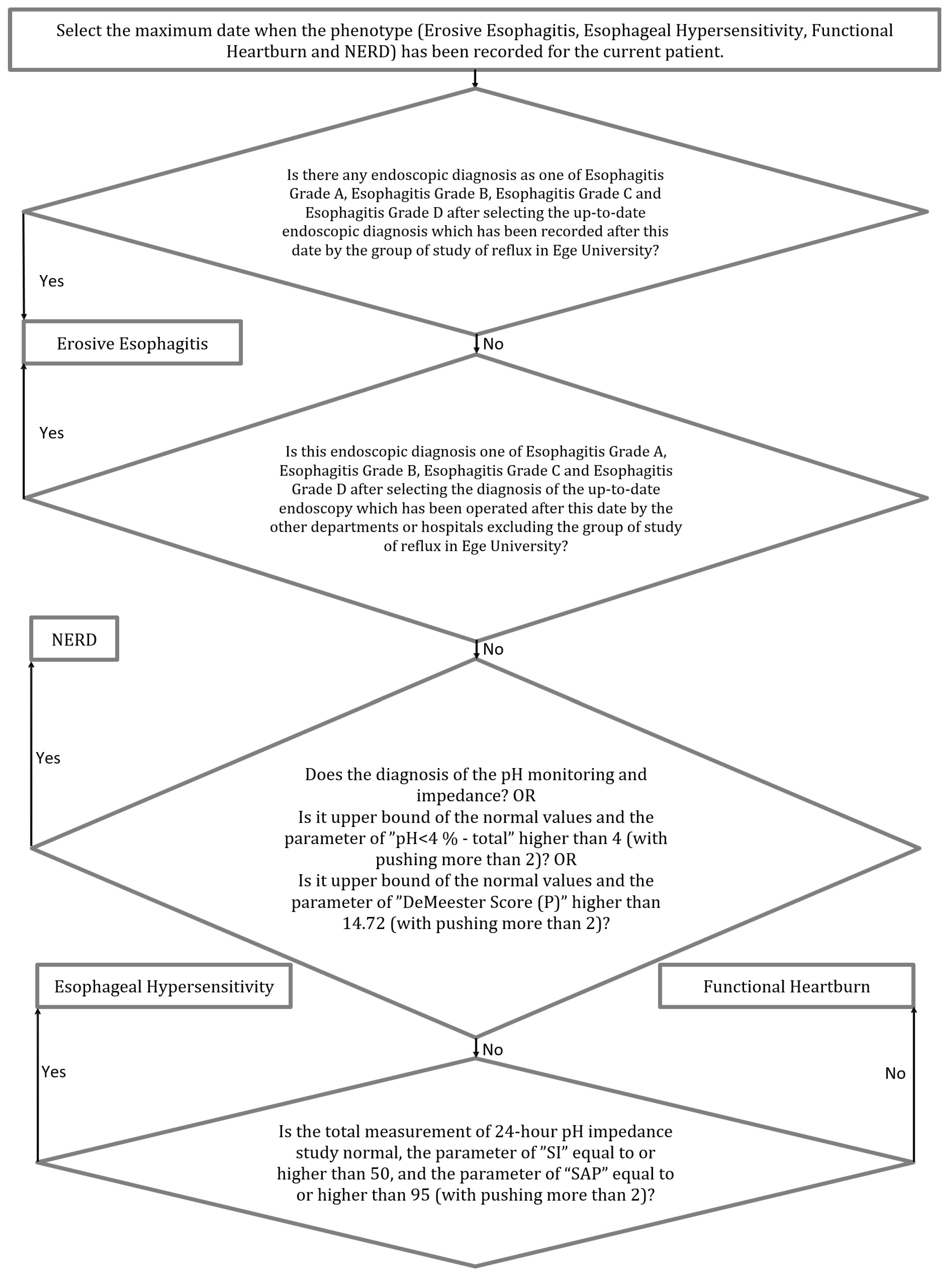Computer-Based Intelligent Solutions for the Diagnosis of Gastroesophageal Reflux Disease Phenotypes and Chicago Classification 3.0
Abstract
1. Introduction
2. Materials and Methods
3. Results
4. Discussion
Author Contributions
Funding
Institutional Review Board Statement
Informed Consent Statement
Data Availability Statement
Acknowledgments
Conflicts of Interest
Abbreviations
| GERD | Gastroesophageal Reflux Disease |
| CC 3.0 | Chicago Classification 3.0 |
| DSS | Decision Support System |
| AI | Artificial Intelligence |
| NERD | Non-erosive Reflux Disease |
| QoLRAD | Quality of Life in Reflux and Dyspepsia Questionnaire |
| SF-36 | Short Form-36 |
| RDQ | Reflux Disease Questionnaire |
| MMS | Medical Measurement Systems |
| PPI | Proton Pump Inhibitors |
References
- Kök, M.; Çekin, Y.; Çekin, A.H.; Uyar, S.; Harmandar, F.; Şahintürk, Y. The role of Blastocystis hominis in the activation of ulcerative colitis. Turk. J. Gastroenterol. 2019, 30, 40–46. [Google Scholar] [CrossRef]
- Bulut, E.A.; Törüner, M. The influence of disease type and activity to sexual life and health quality in inflammatory bowel disease. Turk. J. Gastroenterol. 2019, 30, 33–39. [Google Scholar] [CrossRef]
- Tongtawee, T.; Simawaranon, T.; Wattanawongdon, W.; Dechsukhum, C.; Leeanansaksiri, W. Toll-like receptor 2 and 4 polymorphisms associated with Helicobacter pylori susceptibility and gastric cancer. Turk. J. Gastroenterol. 2019, 30, 15–20. [Google Scholar] [CrossRef]
- Van Brunt, E.E. The Kaiser-Permanente medical information system. Comput. Biomed. Res. 1970, 3, 477–487. [Google Scholar] [CrossRef]
- Winter, A.; Haux, R.; Ammenwerth, E.; Brigl, B.; Hellrung, N.; Jahn, F. Health information systems. Health Inf. Syst. 2010, 1, 33–42. [Google Scholar] [CrossRef]
- Huff, S.M.; Craig, R.B.; Gould, B.L.; Castagno, D.L.; Smilan, R.E. A medical data dictionary for decision support applications. In Proceedings of the Annual Symposium on Computer Application in Medical Care, Washington, DC, USA, 4 November 1987; pp. 310–317. [Google Scholar]
- Farooqui, N.A.; Mehra, R. Design of a data warehouse for medical information system using data mining techniques. In Proceedings of the Fifth International Conference on Parallel, Distributed and Grid Computing, Solan, India, 20–22 December 2018; pp. 199–203. [Google Scholar] [CrossRef]
- Mishra, S.; Panda, M. Artificial intelligence in medical science. Intell. Syst. Healthc. Manag. Deliv. 2019, 1, 306–330. [Google Scholar] [CrossRef]
- Currie, G.; Hawk, K.E.; Rohren, E.; Vial, A.; Klein, R. Machine learning and deep learning in medical imaging: Intelligent imaging. J. Med. Imaging Radiat. Sci. 2019, 50, 477–487. [Google Scholar] [CrossRef]
- Agrawal, S.; Singh, B.; Kumar, R.; Dey, N. Machine learning for medical diagnosis: A neural network classifier optimized via the directed bee colony optimization algorithm. U-Healthc. Monit. Syst. 2019, 1, 197–215. [Google Scholar] [CrossRef]
- Habermann, W.; Schmid, C.; Neumann, K.; DeVaney, T.; Hammer, H.F. Reflux symptom index and reflux finding score in otolaryngologic practice. J. Voice 2012, 26, 123–127. [Google Scholar] [CrossRef]
- Spiegelhalter, D.J.; Knill-Jones, R.P. Statistical and knowledge-based approaches to clinical decision-support systems, with an application in gastroenterology. J. R. Stat. Soc. Ser. A (Gen.) 1984, 147, 35–58. [Google Scholar] [CrossRef]
- Kuhn, K.; Gaus, W.; Wechsler, J.G.; Janowitz, P.; Tudyka, J.; Kratzer, W.; Swobodnik, W.; Ditschuneit, H. Structured reporting of medical findings: Evaluation of a system in gastroenterology. Methods Inf. Med. 1992, 31, 268–274. [Google Scholar] [CrossRef]
- Dormann, H.; Criegee-Rieck, M.; Neubert, A.; Egger, T.; Levy, M.; Hahn, E.G.; Brune, K. Implementation of a computer-assisted monitoring system for the detection of adverse drug reactions in gastroenterology. Aliment. Pharmacol. Ther. 2004, 19, 303–309. [Google Scholar] [CrossRef]
- Ruffle, J.K.; Farmer, A.D.; Aziz, Q. Artificial intelligence in gastroenterology. Precis. Med. Investig. Pract. Provid. 2020, 343–350. [Google Scholar] [CrossRef]
- Adadi, A.; Adadi, S.; Berrada, M. Gastroenterology meets machine learning: Status quo and quo vadis. Adv. Bioinform. 2019, 2019, 1870975. [Google Scholar] [CrossRef]
- Bor, S. Reflux esophagitis, functional and non-functional. Best Pract. Res. Clin. Gastroenterol. 2019, 40, 101649. [Google Scholar] [CrossRef]
- Bor, S.; Kalkan, İ.H.; Çelebi, A.; Dinçer, D.; Akyüz, F.; Dettmar, P.; Özen, H. Alginates: From the ocean to gastroesophageal reflux disease treatment. Turk. J. Gastroenterol. 2019, 30, 109–136. [Google Scholar] [CrossRef]
- Bor, S.; Mandiracioglu, A.; Kitapcioglu, G.; Caymaz, C.B.; Gilbert, R.J. Gastroesophageal reflux disease in a low-income region in Turkiye. Am. J. Gastroenterol. 2005, 100, 759–765. [Google Scholar] [CrossRef]
- Bossuyt, P.; Vermeire, S.; Ferrante, M.; Makino, T.; Bisschops, R. Automated real time endoscopic scoring based on machine learning in ulcerative colitis: Red density reliability and responsiveness study. Endoscopy 2019, 51, 80–81. [Google Scholar] [CrossRef]
- Shung, D.L.; Au, B.; Taylor, R.A.; Tay, J.K.; Laursen, S.B.; Stanley, A.J.; Dalton, H.R.; Ngu, J.; Schultz, M.; Laine, L. Validation of a machine learning model that outperforms clinical risk scoring systems for upper gastrointestinal bleeding. Gastroenterology 2020, 158, 160–167. [Google Scholar] [CrossRef]
- Ruffle, J.; Tinkler, L.; Emmett, C.; Aziz, Q.; Farmer, A.; Yiannakou, Y. PWE-097 Machine learning can accurately classify chronic constipation patients by symptom burden using pain measures alone. Gut 2019, 156, 590–591. [Google Scholar] [CrossRef]
- Guimarães, P.; Keller, A.; Fehlmann, T.; Lammert, F.; Casper, M. Deep-learning based detection of gastric precancerous conditions. Gut 2020, 69, 4–6. [Google Scholar] [CrossRef]
- Song, E.M.; Park, B.; Ha, C.A.; Hwang, S.W.; Park, S.H.; Yang, D.H.; Kim, N.; Byeon, J.S. Endoscopic diagnosis and treatment planning for colorectal polyps using a deep-learning model. Sci. Rep. 2020, 10, 30. [Google Scholar] [CrossRef]
- Danis, N.; Bor, S. Effect of advanced diagnosis modalities and disease phenotypes on PPI response of gastroesophageal reflux disease. Neurogastroenterol. Motil. 2018, 30. Available online: https://gcris.ege.edu.tr/handle/11454/30156 (accessed on 21 April 2023).
- Hançerlioğlu, S.; Yıldırım, Y.; Bor, S. Validity and reliability of the Quality of Life in Reflux and Dyspepsia (QoLRAD) questionnaire in patients with gastroesophageal reflux disease for the Turkish population. Turk. J. Gastroenterol. 2019, 30, 511–516. [Google Scholar] [CrossRef]
- Levine, M.E.; Albers, D.J.; Burgermaster, M.; Davidson, P.G.; Smaldone, A.M.; Mamykina, L. Behavioral-clinical phenotyping with type 2 diabetes self-monitoring data. arXiv 2018, arXiv:1802.08761. [Google Scholar] [CrossRef]
- Vandromme, M.; Jun, T.; Perumalswami, P.; Dudley, J.T.; Branch, A.; Li, L. Automated phenotyping of patients with non-alcoholic fatty liver disease reveals clinically relevant disease subtypes. In Proceedings of the Pacific Symposium Biocomputing, Kohala Coast, HI, USA, 3–7 January 2020; pp. 91–102. [Google Scholar] [CrossRef]
- Kahrilas, P.J.; Bredenoord, A.J.; Fox, M.; Gyawali, C.P.; Roman, S.; Smout, A.J.; Pandolfino, J.E. International High Resolution Manometry Working Group. Chic. Classif. Esophageal Motil. Disord. Neurogastroenterol. Motil. 2015, 27, 160–174. [Google Scholar] [CrossRef]
- Ge, Z.; Wang, B.; Chang, J.; Yu, Z.; Zhou, Z.; Zhang, J.; Duan, Z. Using deep learning and explainable artificial intelligence to assess the severity of gastroesophageal reflux disease according to the Los Angeles Classification System. Scand. J. Gastroenterol. 2023, 1–9. [Google Scholar] [CrossRef]
- Wong, M.W.; Liu, M.X.; Lei, W.Y.; Liu, T.T.; Yi, C.H.; Hung, J.S.; Liang, S.W.; Lin, L.; Tseng, C.W.; Wang, J.H.; et al. Artificial intelligence facilitates measuring reflux episodes and postreflux swallow-induced peristaltic wave index from impedance-pH studies in patients with reflux disease. Neurogastroenterol. Motil. 2023, 35, e14506. [Google Scholar] [CrossRef]
- Emile, S.H.; Ghareeb, W.; Elfeki, H.; El Sorogy, M.; Fouad, A.; Elrefai, M. Development and validation of an artificial intelligence-based model to predict gastroesophageal reflux disease after sleeve gastrectomy. Obes. Surg. 2022, 32, 2537–2547. [Google Scholar] [CrossRef]







| Total Questions | Total Answers | Total Entries | Total Amount of Data | |
|---|---|---|---|---|
| QoLRAD1 | 12 | 84 | 4276 | 48,917 |
| QoLRAD2 | 25 | 175 | 1723 | 38,800 |
| GERD Question Form 1 | 57 | 238 | 653 | 33,942 |
| GERD Question Form 2 | 66 | 353 | 5041 | 189,765 |
| GERD Question Form 3 | 81 | 444 | 1873 | 185,774 |
| SF-36 | 11 | 149 | 5399 | 119,252 |
| Otolaryngology Form (11) | 20 | 115 | 1446 | 21,196 |
| Otolaryngology Score (11) | 9 | 28 | 1602 | 10,603 |
| GERD Postoperative Symptoms Question Form | 22 | 96 | 156 | 2922 |
| RDQ | 2 | 72 | 82 | 906 |
| Eckardt Score | 5 | 17 | 10 | 50 |
| Total | 310 | 1771 | 22,261 | 613,715 |
| Erosive Esophagitis (EE) | Reflux Hypersensitivity (RH) | Functional Heartburn (FH) | Non-Erosive Reflux Disease (NR) | Total | |
|---|---|---|---|---|---|
| Male | 641 | 12 | 48 | 307 | 1008 |
| Female | 590 | 49 | 121 | 284 | 1044 |
| Age (10–19) | 18 | 4 | 2 | 10 | 34 |
| Age (20–29) | 119 | 8 | 18 | 60 | 205 |
| Age (30–39) | 271 | 19 | 42 | 127 | 459 |
| Age (40–49) | 298 | 13 | 49 | 149 | 509 |
| Age (50–59) | 299 | 13 | 37 | 144 | 493 |
| Age (60–69) | 169 | 3 | 19 | 77 | 268 |
| Age (70–90) | 57 | 1 | 2 | 24 | 84 |
| Total | 1231 (60%) | 61 (3%) | 169 (8%) | 591 (29%) | 2052 |
| Male | Female | Age < 40 | Age ≥ 40 | Total | |
|---|---|---|---|---|---|
| Type I achalasia (classic achalasia) | 7 | 7 | 5 | 9 | 14 (11%) |
| Type II achalasia (with esophageal compression) | 10 | 21 | 10 | 21 | 31 (23%) |
| Type III achalasia (spastic achalasia) | 4 | 4 | 1 | 7 | 8 (6%) |
| EGJ outflow obstruction | 1 | 0 | 0 | 1 | 1 (1%) |
| Absent contractility | 4 | 4 | 2 | 6 | 8 (6%) |
| Distal esophageal spasm | 1 | 0 | 0 | 1 | 1 (1%) |
| Hypercontractile esophagus (jackhammer) | 5 | 4 | 0 | 9 | 9 (7%) |
| Ineffective esophageal motility | 37 | 23 | 29 | 31 | 60 (45%) |
| Fragmented peristalsis | 1 | 0 | 0 | 1 | 1 (1%) |
| Total | 70 | 63 | 47 | 86 | 133 |
Disclaimer/Publisher’s Note: The statements, opinions and data contained in all publications are solely those of the individual author(s) and contributor(s) and not of MDPI and/or the editor(s). MDPI and/or the editor(s) disclaim responsibility for any injury to people or property resulting from any ideas, methods, instructions or products referred to in the content. |
© 2023 by the authors. Licensee MDPI, Basel, Switzerland. This article is an open access article distributed under the terms and conditions of the Creative Commons Attribution (CC BY) license (https://creativecommons.org/licenses/by/4.0/).
Share and Cite
Doğan, Y.; Bor, S. Computer-Based Intelligent Solutions for the Diagnosis of Gastroesophageal Reflux Disease Phenotypes and Chicago Classification 3.0. Healthcare 2023, 11, 1790. https://doi.org/10.3390/healthcare11121790
Doğan Y, Bor S. Computer-Based Intelligent Solutions for the Diagnosis of Gastroesophageal Reflux Disease Phenotypes and Chicago Classification 3.0. Healthcare. 2023; 11(12):1790. https://doi.org/10.3390/healthcare11121790
Chicago/Turabian StyleDoğan, Yunus, and Serhat Bor. 2023. "Computer-Based Intelligent Solutions for the Diagnosis of Gastroesophageal Reflux Disease Phenotypes and Chicago Classification 3.0" Healthcare 11, no. 12: 1790. https://doi.org/10.3390/healthcare11121790
APA StyleDoğan, Y., & Bor, S. (2023). Computer-Based Intelligent Solutions for the Diagnosis of Gastroesophageal Reflux Disease Phenotypes and Chicago Classification 3.0. Healthcare, 11(12), 1790. https://doi.org/10.3390/healthcare11121790






